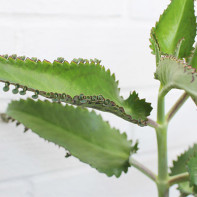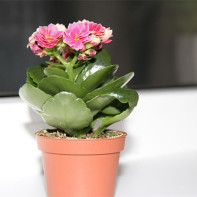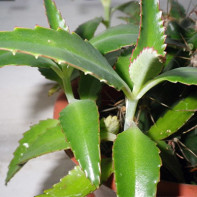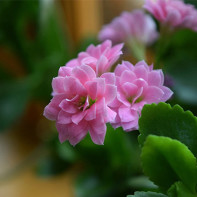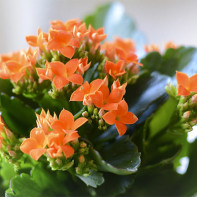Kalanchoe: medicinal properties and contraindications
Kalanchoe is often called home ginseng or room doctor.
- Chemical composition
- How does calanhoe look like
- Types
- Harvesting and storage
- Therapeutic properties of calanhoe
- For Women
- For Men
- In Pregnancy
- For children
- When losing weight
- Kalanchoe in folk medicine
- Diabetes mellitus
- For gastritis
- For the intestines
- For the liver
- Hemorrhoids
- For prostatitis
- For coughs
- For runny nose
- For maxillary sinusitis
- For Joints
- For varicose veins
- For colds
- For warts
- From sore throats
- For burns
- From herpes
- From toothache
- Types of medicinal compositions with calanhoe
- Infusion
- Tincture
- Decoction
- Salve
- Oil
- Juice
- Cosmetic Applications
- For Beautiful Skin
- Lotion for youthful skin
- For beautiful hair
- For hands and nails
- How to Care for Calanhoe
- Can I Eat Leaves Fresh
- Is calanhoe toxic for cats?
- Contraindications to use
Chemical Composition
Calanhoe is a plant rich in various useful substances. Its leaves contain complex carbohydrates, polysaccharides, which are the main sources of energy, flavonoids, very close in composition to human hormones. They contain many organic acids (citric, malic, oxalic, acetic), which support the acid-alkaline balance in the body.
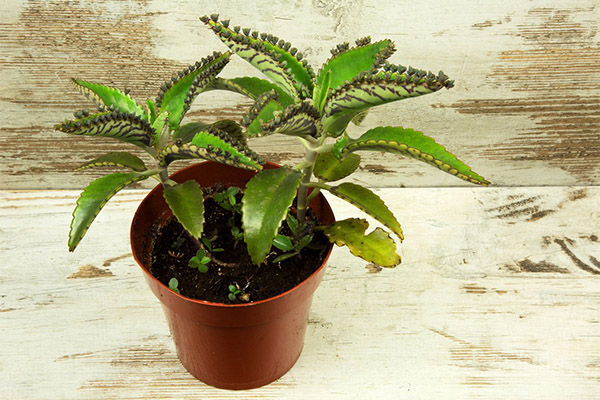
It also contains vitamins C and P, tannins, cardiac glycosides, and many minerals, including calcium, magnesium, aluminum, iron, copper, silicon, and manganese. Each of these substances is essential to the normal functioning of the body.
What does calanhoe look like
It is not uncommon for people to argue among themselves about the indoor plant. One points to a flower with a sharp leaf and says that it is kalanchoe. The other disagrees: Callanchohe has leaves with gently rounded edges. More often than not, both disputants are right: Botanists include almost 200 species of plants in this genus, and they are very different from each other! Some are enormous trees, almost 4 m high, while others are quite tiny bushes, not more than 20 cm high.
Both their leaves and stems are very different from each other: their size, shape and color, which can be deep green or almost blue.
Types
Among this variety of species, only three are used for medicinal purposes: Degremona callanhoe, pinnate callanhoe and Blossfeld's callanhoe.
- Callanhoe Degremona - this flower even grandmothers called the surgeon without a knife, and necessarily diluted in their windowsill, because they were well aware of its medicinal properties. And to this day it is more often than other species are used to treat it in the home. This plant has leathery, elongated leaves, shiny, slightly bent in half lengthwise, with a pointed tip and small denticles all around the leaf. Many tiny plants grow on these denticles, which, despite their small size, are quite complete - right down to their own roots. When these plants fall off, they take great root and take on a life of their own. This non-flowering species of kalanchoe is usually kept in the house precisely because of its medicinal qualities.
- Kalanchoe pinnate is also a frequent resident of window sills. It is grown for its ornamental value and most often it is not even assumed that it is actually useful. And those who are aware of its therapeutic abilities, gave it the name of domestic ginseng. This plant is a flowering plant, although it rarely produces flowers in the apartment. They are small - a little less than 1 cm, have a pinkish-yellowish color and collected in inflorescences, located in the axils of the leaves. The leaves themselves are large, sometimes growing up to 20 cm long and up to 12 cm wide. The leaves are toothed along the edges, in the denticles buds are budded, which are used to propagate the plant. This type of kalanchoe is grown on an industrial scale to produce medicines for dentistry, surgery, and gynecology.
- Kalanchoe Blossfeld is a third species, widely grown in homes and suitable for medicinal applications. It blooms very decoratively with white, red or orange small flowers gathered in fairly conspicuous inflorescences. It usually blooms in winter and enjoys bright flowers almost until May. The leaves of Blossfeld's kalanchoe are not very large, about 5 cm, but they are juicy, shiny and fleshy.
These three species are virtually identical in their medicinal qualities and can be used to treat the same diseases.
Florists, who are passionate fans of kalanchoe, grow several other species of this plant, but they no longer have practical applications and are not used for the preparation of medicinal remedies.
Harvesting and storage
Since kalanchoe grows at home all year round, there is no special need to procure kilos of the plant in advance. At any time of the year, you can go to the window sill and pick the necessary leaf, if the need is urgent.
If you decide to prepare a medicinal composition for a planned treatment, you need to stop watering the plant for a week before collecting raw materials. At the end of this period the leaves should be cut (it is best to choose those that grow at the bottom), washed, wiped with a towel and stored in the refrigerator for another 5-7 days. Let them lie in a drawer for fruit: thus there is a start of the biological mechanisms of production and accumulation of useful properties. And only after that you can prepare decoctions, tinctures, infusions and other medicines, as well as squeeze the juice.
Therapeutic properties of kalanchoe
Thanks to a large number of vitamins, trace elements and other natural substances, kalanchoe has an extensive list of useful abilities that allow you to use the plant for medicinal purposes. In particular, it is able to destroy dangerous microorganisms, that is, it has inherent bactericidal properties. Kalanchoe can stop the growth of bacteria, in other words, it has bacteriostatic properties.

In practice, its ability to inhibit inflammation, stop blood, pull dead tissues from wounds (that's where the name "surgeon without a knife" comes from) and heal injuries is used. Medicine uses it in a variety of applications. For example, otorhinolaryngologists treat angina, rhinitis, maxillary sinusitis. Flu, acute respiratory infections and acute respiratory viral infections are also in the scope of the plant. In dentistry, the properties of the plant are used to combat stomatitis, gingivitis and periodontal disease. It also helps to solve skin problems and treats eczema, acne, psoriasis.
The plant is very widely used in the treatment of all kinds of wounds, ulcers, erosions, fissures, varicose veins.
For women
Kalanchoe is also successfully used in the treatment of gynecological diseases. It can help cervical erosion healing, cervical mucosal inflammation (or cervicitis). After childbirth, the juice of the healing plant promotes rapid healing of ruptures and deep fissures of the perineum. For this purpose, it is recommended to put a gauze cloth moistened with juice on the wound for a few minutes, having previously lubricated the skin around the fissure with furacilin ointment or synthomycin emulsion. As a rule, for such procedures will be enough for 5 days.
To heal cracks in the nipples, which often appear in women immediately after childbirth, just starting to breastfeed, will also help calanhoe. To do this, its juice should be dripped on the nipples from 4 to 5 times a day. It is most convenient to use a dropper. Cracks will disappear in about 6-7 days.
Flavonoids contained in the healing plant will help you to more easily survive unpleasant symptoms during the pre- and postmenopause. They are similar in structure to female sex hormones and have the ability to reduce the amount of lipids in the blood and weaken the rate of oxidative processes, which makes the process of aging of the body smoother and less painful.
For men
This natural medicine can be successfully used not only by women, but also by men. In particular, it helps to improve health with adenoma of the prostate and prostatitis, which is uncommon in men who do not move much, have excess weight. For these reasons, in the pelvic organs is difficult blood circulation, which causes the disease. For treatment, either fresh calanhoe leaves or alcoholic tincture is used. The leaf can be applied to the sore spot as a whole, from the tincture to make compresses.
Also, thanks to the presence in the plant flavonoids it is a good preventive agent against prostate cancer. The benefits of kalanchoe is confirmed by studies. Certain compounds can prevent the development of prostate cancer. The beneficial properties of flavonoids for men were confirmed by a study, which proved that the risk of this disease is reduced by 30% if you regularly chew a leaf of calanhoe.
When pregnant
Every pregnant woman, trying to save the future baby from the negative effects of chemical medicines, tries to find folk remedies for the treatment of colds. In this case, a good helper will be calanhoe: its juice can treat runny nose. In order not to get burned mucous membranes, it is better to dilute the juice in half with boiled water. The resulting drops should be put into the nose in the morning and evening. As a result, mucus is released much less, the woman is able to breathe freely.
Those who have high blood pressure or have a predisposition to it, to use such a remedy should be extremely careful. It is also possible individual intolerance to the plant.
For children
Treating runny nose in children with calanhoe is a long-standing tradition, in some families this method is used for several generations. It is important to remember that babies under a year should not use calanhoe. Those who are older, you can only bury the decoction of the plant, but not the juice. When a child is older, and he was 10 years, you can start making drops of juice, and be sure to dilute it with boiled water in equal proportions. Good help as cotton swabs soaked in these drops, if you put them in each nostril for 5-6 minutes in the morning and evening. Do not add the juice of other plants - such as aloe or onions - to the drops for children.
Before dropping the healing liquid into the child's nose, it is necessary to conduct a sensitivity test - put one drop on the inner surface of the elbow and watch to see if redness appears. This rule applies to children of all ages, and all dosage forms - both juice and decoction.
Doctors do not recommend compositions based on this plant, if the child has a fever.
Parents need to understand that the drops from calanhoe help only with inflamed adenoids, colds, acute respiratory infections or acute respiratory viral infections. They do not get rid of a runny nose of an allergic or physiological nature, in such cases you need to look for other means.
When losing weight
The apparent effect of calanhoe for weight loss is not noticed, but if you use it as a strengthening and organizing digestive means, it is quite suitable for inclusion in a comprehensive weight loss program.
Callanhoe in folk medicine
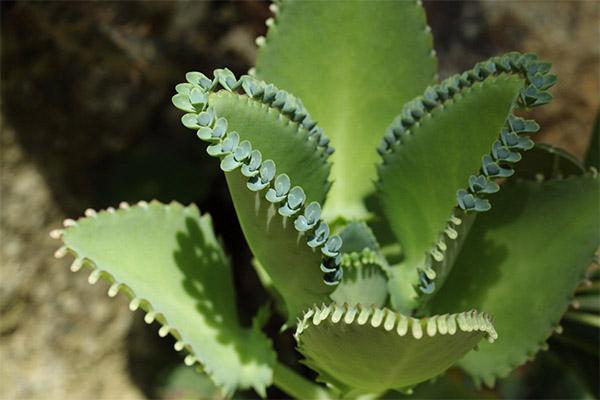
Diabetes mellitus
If a patient with diabetes consults a doctor about the benefits of calanhoe for diabetes, the doctor will definitely explain that in this disease the body needs a constant supply of calcium, which is in sufficient quantities in the juice, squeezed from the leaves of the plant. If the patient normally tolerates calanhoe, you can safely take it a tablespoon per day. The main thing is not to overdo it and do not try to increase the dose. On the course of diabetes, it will not have a positive effect, and you can hurt yourself.
You can add insulin to the juice and take this composition for a month. But first you need to consult a doctor.
In addition, those who suffer from diabetes often have problems with their legs. Even the smallest injury, a scratch or blister can provoke a large infectious process and develop into a trophic ulcer. Such ulcers are also treated with calahoe juice mixed with novocaine, lanolin and furazolidone.
Rub the sore spot up to 4 times a day. At first the ulcer will sting and tingle quite noticeably, but after 7 minutes the painful sensations will pass.
You can apply lotions to the ulcers, using calanhoe juice with the addition of aloe juice. You need to mix the juices equally, soak them in a bandage and apply to the wound.
Gastritis
Gastritis is treated by taking the juice of calanhoe inside. It has a beneficial effect on the mucous membrane of the stomach, reducing and then removing the inflammation, spurring tissue repair and reducing pain. To ease the course of gastritis, you can drink a teaspoon of juice 3 times a day.
If you mix the juice in half with an infusion of juniper berries and leaves of goldenseal and fennel, and then drink this remedy by the tablespoon, the secretory activity of the stomach will increase, making it easier to digest food. Therefore, it is necessary to take the healing composition before meals.
For the intestines
To treat intestinal problems, you need to prepare an alcoholic tincture: in a completely dry jar of dark glass pour chopped leaves about one-third of the volume and fill the container to the top with alcohol. Infuse a week in the corked form, after straining store in the same container of dark glass. Used not only for the treatment but also for the prevention of gastroduodenitis, colitis and enterocolitis: the norm intake per day - a teaspoon for 15-20 minutes before each meal (snacks are not considered).
To relieve acute colitis, you need to mix the tincture with decoction of the herb yarrow. This remedy acts gentler, and the taste is not so pungent. It is necessary to pour a tablespoon of grass with a small glass of water, boil on low heat for 10 minutes and when it cools, strain the decoction. Dilute the tincture with decoction in half, take from 5 to 7 times a day with a tablespoon. Pain will decrease, stools will come to normal, appetite and the condition of the body as a whole will improve.
The acute exacerbation of chronic colitis can be prevented by taking such a remedy: take equal parts of the leaves of calanhoe and plantain, grind them and pour a very small amount of water - so that it only covered the mixture of leaves. Squeeze the liquid after 20 minutes and drink the healing composition by the tablespoon 3 times a day. After a course of 15-20 days you need to take a break for a month.
For the liver
All problems in the liver and gallbladder, usually due to inflammation, resulting in impaired bile formation, there are various stagnant phenomena.
With these problems will help a collection, which contains calanhoe. It is necessary to take calendula, dill seeds, baby calanhoe, juniper fruits (2 tablespoons each). Add chamomile, strawberries, rose hips, horsetail, corn stover (4 tablespoons each). Pour 3 tablespoons of the collection of half a liter of boiling water, to insist an hour and a half, strain and take a whole glass for 15 minutes before meals 3 times a day.
Another collection: Take a spoonful of St. John's wort and as many calanhoe shoots in a glass of boiling water. Pour and insist 2 hours. Add to tea by the tablespoon. Drink a course of 5 to 7 days.
Important: Before using liver gatherings you need to make an ultrasound!
Hemorrhoids
The use of compositions with kalanchoe for the treatment of hemorrhoids is based on its ability to reduce inflammation, normalize blood circulation and relieve pain. To do this, you can make compresses, lotions or baths.
Soak a gauze cloth in the juice of the plant and gently apply it to the inflamed and enlarged hemorrhoidal node. Hold the healing composition on the sore spot for 15 to 20 minutes.
Baths are good for hemorrhoids. For them, half a glass of juice should be mixed with an infusion of the following set of herbs: horsetail (30 g), oak bark (50 g), valerian root (20 g). To get the infusion, one tablespoon of the mixture is enough. Pour it with half a glass of boiling water. After an hour's infusion, the healing composition is ready. Pour the infusion mixed with calanhoe juice into a bowl with warm water (it should not be hot!) and sit in it for 15 minutes.
Not bad acts on the hemorrhoidal nodes of an ointment from the juice of calanhoe and petroleum jelly, taken in the proportion 1:3.
From prostatitis
To treat inflammation of the prostate, an alcoholic tincture is used. You need to take 100 g of leaves and pour them 200 ml of alcohol. Filter the medicine after insisting for 10 days in a dark place. Take the medicine internally - before breakfast, one teaspoon, and an hour before going to bed at night. As soon as you feel an improvement, it is better to reduce the dosage.
You can use another scheme of using the tincture - drink it once a day, on an empty stomach, but increase the amount to 1.5 teaspoons. In this case, continue to take it until the symptoms completely disappear.
Each patient chooses the appropriate method of treatment for himself - but only after consultation with the doctor.
For preventive purposes, it is recommended to chew a piece of a fresh leaf of calanhoe every day.
From the cough
If tormented by an attack of a prolonged cough, help a mixture of calanhoe juice with melted butter in the ratio of 1:1. Before having breakfast, lunch or dinner, you should drink a tablespoon of this remedy.
Another old-fashioned, but sure way: cut the bottom of the black radish, make a hollow in it and put it very finely chopped leaves of calanhoe and a spoon of honey. Cover the recess cut off the bottom and put the radish in the refrigerator. When the juice is released, drain it and drink a tablespoon before meals. The radish can be reused, and the calanhoe is better crushed anew.
For the runny nose
An excellent remedy for a runny nose is obtained from a mixture of calanhoe and aloe. You need to mix in equal proportions the juice of these two plants. You can prepare at once a daily rate and store in the refrigerator. In each nostril drop 3 drops.
Excellent reputation for the treatment of runny nose and in a duet with an onion - the juice of both plants should also be mixed in half. However, not everyone will suit this rather aggressive mixture - it may well burn the mucosa. Therefore, before dripping into the nose, it is necessary to apply the composition to the inner bend of the elbow. If no redness appears, you can safely use it to combat a runny nose.
Another option for home drops from a runny nose is the juice of calanhoe with decoction of St. John's wort or melissa. Liquids mix in equal proportions. Such a composition not only allows you to breathe normally, but also has an antimicrobial and anti-inflammatory effect.
These remedies are only suitable for adults, in children under 10 years they can burn the mucosa. Children are better to treat runny nose with decoction of calanhoe.
If you have maxillary sinusitis
If a cold or acute respiratory infections went too far and the patient was diagnosed with maxillary sinusitis, it is necessary to treat with a tincture of kalanchoe with aloe: 3 times a day to drop in 2 drops. The head should be tilted back.
To cure went faster, you can additionally once a day, preferably before going to sleep, place in the nostrils for 5-6 minutes cotton swabs with the ointment applied to them. It also can be easily prepared at home: a tablespoon of calanhoe juice mixed with 50 g of petroleum jelly and the same amount of lanolin.
If the inflammation has spread to several sinuses and sinusitis has developed, you need a stronger and more effective ointment. To prepare it, add a teaspoon each of aloe, onion and cyclamen root juices to the previous recipe, mix and put in the resulting mixture Vishnevsky ointment (10 g). Treatment with this composition should be carried out 3 times a day. The total course lasts 25-30 days.
For joints
We must remember: formulations with calanhoe for the treatment of joint problems apply only externally! In this case, they will not cause complications, will be useful, improve motor activity, remove inflammation and pain.
To prepare a composition for rubbing, 4 tablespoons of crushed leaves need to pour half a liter of alcohol in a glass or enamel container. Under a tight lid, insist the composition for about two weeks. Store the finished product in the refrigerator, and rub them on painful joints - once a day.
You can get rid of pain with a compress, for which mix an alcoholic tincture with chalk and one or two spoons of kefir. The consistency of the mixture should be similar to sour cream.
At night, before going to bed, you need to smear the painful joints with the prepared remedy, cover with plastic wrap and wrap with a bandage or a suitable cloth. Sleep with such a compress all night.
You can make another composition for rubbing: mix in equal proportions of honey, calanhoe juice and grated black radish. Before using this remedy, you should allow it to infuse a couple of hours.
A good effect is obtained from the rubbing with the help of a composition of juice and grated (or crushed in a meat grinder) horseradish.
For varicose veins
On the veins, a good effect has an alcoholic tincture of calanhoe, which stimulates blood circulation in the legs. Therefore, those who suffer from varicose veins can rub in the legs in the upward direction - from the foot to the thighs - a tincture of calanhoe. It improves blood microcirculation, which will significantly reduce the number of spider veins. Relief of heaviness in the legs, pain reduction, getting rid of cramps will not take long. To get a stable curing effect for a long time, it is necessary to carry out procedures with the tincture for at least four months.
The tincture should be prepared from 2 tablespoons of crushed calanhoe leaves and half a liter of vodka. Insist the composition for 10-12 days, shaking about once a day.
If you have a cold
To get rid of germs and viruses, it is very good to chew the leaves of calanhoe. This, by the way, will help soften the throat and ease the cough.
The cough can be cured by taking the juice, diluted in half with boiled water. It is enough to take half a tablespoon twice a day. The same composition can also be used as nasal drops. When you have a cold, you need to drop the drops - 3 to 4 times a day. If you add a little aloe juice to the drops, such a composition will act faster and softer.
From warts
Warts and papillomas can be treated with the leaves and juice of calanhoe. It is better to use the healing plant after it has been in the refrigerator for two weeks. There are several ways to get rid of these skin problems.
- First, you can simply rub the juice of calanhoe in the morning and evening in the wart. Already on the second day you will notice how the wart began to respond to treatment with a change in color.
- Secondly, as a salutary remedy you can take an alcoholic tincture of calanhoe. To prepare it, mix 100 ml of vodka with 3 tablespoons of finely chopped leaves of the plant. After a week of infusion in a dark, warm room, the cure is ready. Rub it into the wart in the morning and evening until it disappears.
- Thirdly, to defeat warts can be an ointment made from the juice of calanhoe. It should be mixed with olive oil, and take it 2 times more than the juice. The resulting composition to keep for half an hour with constant stirring in a water bath. When cooled, you can rub into the growths on the skin.
To make the calanhoe acted more effectively, before any of the above procedures, you need to massage the wart with a decoction of wormwood, celandine or calendula.
When sore throat
Drops of calanhoe with aloe, prepared for nasal drip for a runny nose, can also be used to treat angina and tonsillitis. For gargling, the drops need to be diluted in equal proportions with boiled water - and the solution is ready. To treat not only your throat, but also your nasopharynx, you can use this diluted solution 4-5 times a day to put drops in your nose - 2 drops in each nostril. Such a composition can also be used to treat children.
From burns
If you have frostbite, you can simply drip calanhoe juice on the injured area. The procedure should be repeated 3 to 4 times a day.
You can not squeeze the juice, but use a whole leaf of the plant, putting it on the wound and securing it with a bandage. After 4 hours, change the leaf and take a fresher one.
If the wound is extensive enough, and one leaf is not enough, you can soak a gauze napkin in the juice and apply it. Such a bandage must be removed after 5 hours.
For herpes
You can relieve itching and burning with herpes rashes with the help of calanhoe juice thanks to its immunostimulatory and antiseptic action. You can enhance the effect of the juice, adding a little honey. Suitable such a composition not only for smearing rashes, but also for ingestion.
You can not squeeze the juice, and use the crushed leaves. To do this, take equal parts of the mass of leaves and honey, mix the components and let stand for 10 hours. Eat this delicious medicine by the tablespoon 3 to 4 times a day.
For toothaches
The action of calanhoe juice is very similar to novocaine, so it can be used to neutralize a toothache. Crushed leaves should be applied to the cheek, covered with plastic wrap and wrapped with a warm scarf to accelerate the process of pain relief.
Relieves the pain of the alcohol tincture and for various problems in the oral cavity - stomatitis, gingivitis and periodontitis. You can gargle with just the alcohol tincture alone, or dilute it with a tincture of calamus. Instead of gargling, you can make applications: soak gauze napkins in the juice of the plant and apply to the gums.
With stomatitis a good effect have tampons soaked in the juice of calanhoe. Repeat this procedure should be up to 4 times a day, keep the swabs for 10-12 minutes. The relief will come quite quickly.
Types of medicinal compositions with calanhoe
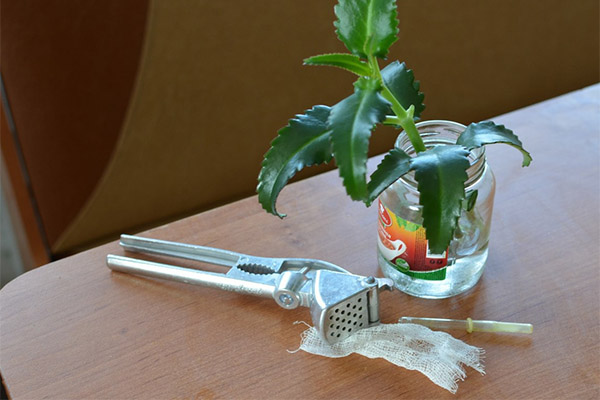
Infusion
To prepare an infusion of crushed calanhae leaves, pour boiling water in an enamel pan. For external use, the proportions should be 1:5, for internal - 1:10. Then the composition to simmer in a water bath for 15 to 20 minutes under a closed lid.
The infusion can be used as lotions to treat burns, boiled wounds, varicose veins, skin problems. They gargle the throat, mouth with inflammatory phenomena.
Inside, this composition is recommended to take for the treatment of diseases of the digestive system, getting rid of gynecological problems. It has also proven itself in cases of gastritis with reduced acidity and chronic colitis. With colitis, the infusion is recommended to take half an hour before meals twice a day for a month.
Tincture .
Tincture in alcohol has a fairly long shelf life - a year. Therefore, you can prepare this medicine at once more. You need to take leaves that have lain in the fridge, cut them and fill with them a half-liter bottle, pour alcohol or vodka in the same bottle. The bottle should be corked tightly and put in a dark place for a week. During this time, it should be shaken 6-7 times. Then strain the composition, pour into another glass container and store in the refrigerator until necessary. It can be used to treat varicose veins, pustular inflammation.
Decoction
Such a decoction, popularly called sneezing, can be used to treat runny nose in children under three years of age. To prepare it, 4-5 leaves of the plant need to pour 100 ml of water and bring to a boil on low heat. Remove and leave for another hour, then strain and pour into a glass dish. Put one drop in each nostril. Usually after the injection, the baby sneezes. This is a normal reaction to the medicine. The runny nose passes in two or three days after such treatment.
Salve
Ointment made of calanhoe is quite popular. It is used for sores, wounds and fistulas. If you put a napkin grease on an abscess, a frostbitten area or anoint a skin rash, it will soon cure acute pain. Cosmetologists use the ointment to get rid of acne, lighten dark spots. It is also good for patients with varicose veins. Even a runny nose can be treated with the ointment: in such cases, each nostril should be treated from the inside with the medicine, applied to a cotton swab. During flu and SARS epidemics, this method will keep the virus away.
To prepare the ointment, you need to take a tablespoon of calanhoe juice and add to it 100 grams of lanolin and 0.25 grams of novocaine and furazolidone each. All mixed well, so that the composition as a result had the consistency of thick cream. Store the ready-made ointment at room temperature.
Oil .
In olive oil you need to pour freshly squeezed juice of calanhoe in a ratio of 1:1. Mix the composition and insist in a dark room for three days. The oil is ready. It can be used for cosmetic purposes (for example, on its basis prepare masks, adding decoctions of other medicinal plants - chamomile, calendula, succession) or in the complex treatment of stomach ulcers. Then in the oil you need to add a little bit of honey, boiled in a water bath for half an hour.
Juice
To get enough juice and at the same time of good quality, which has a lot of useful substances, you need to prepare the leaves of the plant, which is at least two years old. Planning to harvest the juice, you need to stop watering 7 days in advance. It is better to cut the most fleshy and large leaves - they will get more healing juice.
The leaves are washed, dried with a towel and put in the refrigerator, after a week they will stand and accumulate useful substances, crush. You can crush kalanchoe with a blender, meat grinder or garlic presser, and then squeeze the juice with gauze. Pour the squeezed juice into a glass jar with a well-fitting cork and put it in the refrigerator. Do not store the finished product longer than two to three weeks.
Cosmetic applications
Home beauty products made of calanhoe are very effective and quite popular. Women have learned how to use its useful properties to be beautiful, for which they prepare masks or lotions. However, you should remember: if the cosmetic has caused irritation or appeared any other negative reaction, procedures should be discontinued.
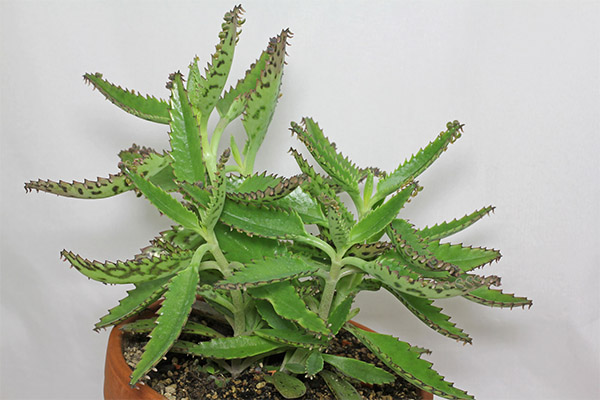
For a beautiful complexion
Kalanchoe is able to normalize the skin, clear the pores, remove excess fat, get rid of rashes, lighten pigment spots.
To cleanse the skin and get a beautiful color, you need to remove the skin from the leaf and rub the pulp on your face. Then lightly slap the skin and wait until the healing composition is absorbed. Without washing, immediately put a moisturizing cream on your face.
If you need to dry out a little too oily skin, linden, chamomile and mint leaves should be poured into a small amount of boiling water and after half an hour drain the water. Combine calanja juice with steamed herbs and apply to the skin for about 20-25 minutes.
Lotion for youthful skin
This remedy can be used not only on oily, but also on dry skin. Mix a tablespoon of juice and half a cup of boiled water with a teaspoon of honey. Use this remedy after an evening wash as a grooming agent.
For beautiful hair
Useful remedies based on calanhoe - masks and decoctions - make hair stronger, thicker and softer, give it a beautiful shine.
For the mask, you need to mix a teaspoon each of calanhoe, garlic and birch juices, as well as honey. Add an egg yolk and mix. Apply to the hair, distribute the mask on the entire length of the hair, wrap the food film on the head and over it - a large towel. After 2 hours wash off the mask with shampoo.
For hands and nails
Kalanchoe does an excellent job of softening the hands. In addition, thanks to its antiseptic properties, its juice treats nail fungus, as a result, both the nail plate and the cuticle soon return to a normal, healthy state.
You can mix a drop or two of calanhoe juice with regular hand cream, which is used daily. It is better to lubricate your hands before going to bed and then wear special cotton gloves.
To get rid of fungus, each fingernail should be wrapped with gauze soaked in the juice. Then put on cotton gloves. Repeat the procedure every day, at most every other day, until the fungus disappears.
How to properly care for calanhoe
Kalanchoe is quite unpretentious, but does not like the very hot sun, the best place for it is the east window, where the sun is only until lunchtime. The room should be aired often, but draughts do not like the plant.
The temperature should be kept in summer +20 ... +25 ° C, and in winter - +15 ° C, otherwise kalanchoe can die. In summer it would be good to take the plant on a balcony or veranda.
Do not water kalanchoe very abundantly, it does not tolerate overwatering, because the roots can begin to rot. Soil between waterings should have time to dry out. In summer you need to water once every 3-4 days, in winter the break should be from 8 to 15 days. Water should stand for 24 hours before watering.
The plant grows quickly, it needs to be transplanted often, but it is better to do it in the spring. The pot should be 3-4 cm wider than the previous one, on the bottom necessarily pouring drainage, so that the roots do not rot. The soil is best made from a mixture of leaf and turf soil.
Propagated by cuttings, seeds and offspring.
Can I Eat Leaves Fresh
People first noticed the medicinal abilities of calanhoe and only then decided to try to use it for culinary purposes as well. This plant is rich in vitamins and minerals, so the meals made of it are really useful, but since its leaves have a bitterish taste, they are not widespread. Such dishes are more suitable for those who are interested in therapeutic nutrition, as they help to restore the body after surgery or a grueling illness, help cleanse the blood, protect against colds, remove harmful substances.
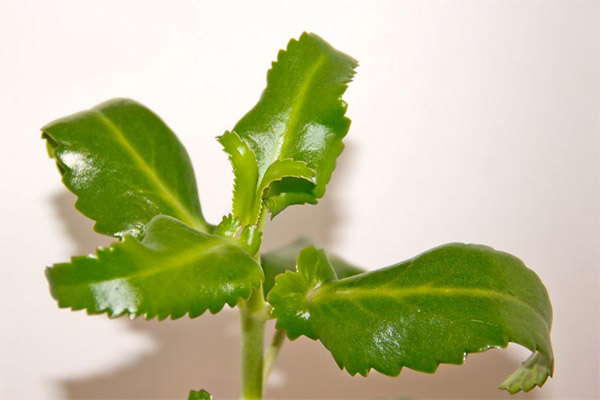
The best way to reduce the tartness and bitterness of kalanchoe is cucumber, so in combination with it the healing plant is quite possible in a salad.
Not bad combination of calanhoe with carrots or avocado, green salad, fresh peas in a dressing of olive oil with the addition of lemon juice.
You can try to prepare a vinaigrette with calanhoe. For it, as usual for such a dish, you will need to boil 3 potatoes, one beet and one carrot each. Peel and cut the vegetables, add two sliced pickles and a handful of sauerkraut. Also add pickled mushrooms (40g), Callanjoe leaves (30-40g), green onions. Season with salt and add sunflower oil, preferably in an unrefined oil with a smell of sunflower seeds.
Is calanhoe toxic for cats?
Cats quite often try to chew on houseplants, and not all inhabitants of the house windowsill are useful or at least harmless for them. So, for example, although calanhoe is considered a medicinal plant, it is dangerous to the cat, because it can seriously compromise the health of the pet and even cause poisoning. It causes irritation of the gastrointestinal tract, resulting in vomiting and diarrhea. The juice of the plant can, in some cases, even provoke heart problems, up to and including heart rhythm disturbances.
Contraindications to use
Any medicinal plant has contraindications, and kalanchoe is no exception. And if as an external remedy it is practically safe, in some diseases it is possible to worsen the well-being when used internally. To avoid this, remember that you can not use calanhoe, if there is an allergy to the plant components and individual intolerance.
Treatment is also contraindicated in patients with bronchial asthma and severe diabetes, when the body is severely weakened. Direct contraindication is low blood pressure, cirrhosis of the liver and hepatitis, diseases of the joints and cancer problems.
Inside can not be used in pregnant women to avoid miscarriage. External use of the plant by future mothers is quite acceptable.
«Important: All information on this site is provided solely for informational purposes. Consult with a medical specialist before using any recommendations. specialist. Neither the editors nor the authors shall be liable for any possible harm caused by materials."

